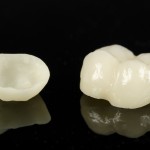
Ceramic materials are regularly used for conventional tooth supported single crowns. All-ceramic crowns have better aesthetic qualities and are considered preferable for anterior crowns. All-ceramic crowns are also used in the posterior as an alternative to metal-ceramic and metal crowns but their use is under debate.
The aim of this review was to compare the difference in longevity for any all-ceramic material used to restore anterior and posterior teeth, not involved with fixed dental prostheses or posts.
Methods
Searches were conducted in the Medline, Embase and Cochrane library databases. These were supplemented by hand searches of the journals, International Journal of Prosthodontics, the International Journal of Computerized Dentistry, the Journal of Oral and Maxillofacial Implants, and the Journal of Prosthodontics.
Randomised controlled trials (RCTs), prospective and retrospective studies in adults over 17 yrs of age reporting on all-ceramic full coverage crowns but not involving implant supported crowns or non-vital teeth were considered. Only English language studies were included.
Two reviewers independently selected studies with outcomes being assessed at a binary level of success or failure. Failure included any event that affected the crown, examples being chipping, fracture, caries, loss of the crown, whereas, success recorded no adverse events. A relative risk meta-analysis was carried out.
Results
- 14 studies (9 prospective 5 retrospective) were included.
- Follow up periods ranged from 36-223 months.
- Combined failure rates
- Anterior crowns = 6.5% (range 0-10.8%).
- Posterior crowns = 9.1% (range 0-45%).
- Rates for different material are shown in the table.
| Failure rates | ||
| Anterior | Posterior | |
| Slip cast alumina | 10.4% | 9.2% |
| Lucite reinforced | 0.0% | 3.6% |
| Pure alumina | 3.2% | 10.9% |
| Zirconia | 4.4% | 9.0% |
| Lithia disilicate | 6.9% | 2.3% |
- The relative risk for the failure of anterior all-ceramic crowns compared to posterior all-ceramic crowns is shown below.
| Follow-up period | Relative risk | 95% CI |
| 3-4 years | 0.65 | 0.17 – 2.48 |
| 5-6 years | 0.5 | 0.33 – 0.76 |
| 7 or more years | 0.74 | 0.19 – 2.72 |
Conclusions
The authors concluded: –
These results indicate that there were differences in failure between anterior and posterior all ceramic crowns but the difference was only 3%. Although this has clinical relevance and some caution is needed when prescribing all ceramic posterior crowns the difference was relatively small. Lithium disilicate restorations were observed to have higher failures on anterior restorations and more research is needed to investigate why.
Comments
The authors have undertaken a broad search for papers to address they question although restricting the inclusion criteria to studies published in in may mean that relevant studies have been excluded. Both pro- and retrospective study designs have been included and this should be taken into consideration when considering the findings as no quality assessment of the included studies has been presented. This would have been helpful, as retrospective studies designs have a greater risk of bias and as the authors highlight no RCTs were available. In considering the findings the wide definition of corn failure used should also be taken into account. The authors also highlight that the studies were analysed per tooth (or per crown) because of the presentation of the data in the original studies. Ideally this should be analysed per patient because of the potential impact of clustering.
Links
Primary paper
Kassardjian V, Varma S, Andiappan M, Creugers N, Bartlett D. A systematic review and meta analysis of the longevity of anterior and posterior all-ceramic crowns. J Dent. 2016 Sep 1. pii: S0300-5712(16)30166-X. doi: 10.1016/j.jdent.2016.08.009. [Epub ahead of print] PubMed PMID: 27594093.
Other references
Dental Elf – 12th Aug 2015

All-ceramic crowns: failure rates higher in posterior teeth? https://t.co/6Xw2mCwLWf
[…] post All-ceramic crowns: failure rates higher in posterior teeth appeared first on National Elf […]
All-ceramic crowns: are failure rates higher in posterior teeth? https://t.co/6Xw2mCwLWf
Review suggests little difference in failure rates of all-ceramic crowns in anterior & posterior teeth https://t.co/6Xw2mCwLWf
Failure rates of all-ceramic crowns in anterior & posterior teeth – little difference? https://t.co/6Xw2mCwLWf
Small differences in failure between anterior and posterior all ceramic crowns suggests review https://t.co/6Xw2mCwLWf
Don’t miss-All-ceramic crowns: are failure rates higher in posterior teeth? https://t.co/6Xw2mCwLWf
[…] Sep 2016 – All-ceramic crowns: failure rates higher in posterior teeth […]
[…] All-ceramic crowns: failure rates higher in posterior teeth […]